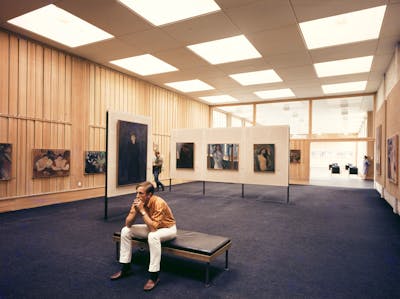Bringing the old Munch museum to life
The iconic building is turned into a pop-up Neighbourhood Lab, alternative exhibition space and culture house

The Munch Museum by architects Gunnar Fougner og Einar Myklebust. Photographed in 1963, shortly after completion,
Photo: Teigen Fotoatelier/Norsk Teknisk Museum/DEXTRA.
From the future of streets to social infrastructure. A rich exhibition and extensive events program open up neighbourhood issues to both a global and a local public.
We bring the Old Munch Museum to life through talks, workshops, conferences, local activities, social gatherings, concerts and art projects. This revitalisation is a collaboration with the City of Oslo’s Property Agency (Oslobygg), the Agency of Cultural Affairs (Kulturetaten), and the district (Bydel Gamle Oslo).
At the heart of the Lab there will be a rich exhibition of neighbourhood projects and practices. The exhibition includes commissions, selections from the Triennale’s international open call, projects in development in Oslo, artistic interventions, student projects, and local initiatives. We deliberately mix bottom-up and top-down, international and local, commercial and critical, academic and popular approaches. Just as a great neighbourhood needs to include all of the above, we believe the exhibition should do too.

The ambition is to show inspiring projects and practices that contribute to neighbourhood quality. Our research and development process, carried out in the last years, has led us to approach the neighbourhood through different lenses that will be present in the Lab activities and exhibition.

Photo: Jaja architects.
Our streets: Making new sense of neighbourhood life and mobility
Streets are the veins of a city, as well the potential site for the neighbourhood to come together. While mobility solutions are rapidly changing, the car still dominates the urban scene and takes up enormous amounts of space. How can streets be designed or transformed from serving cars to becoming an asset for the neighbourhood? How is infrastructure becoming a community asset? How can infrastructure enable local actors to use it and co-create activities?

Olafiagangen in the Oslo neighbourhood of Grønland, being activised by temporary activities. Photo: Growlab.
Social Infrastructure: Cultivating diverse and thriving spaces
Neighbourhoods in cities over the world are under threat of becoming mono-cultural areas of housing and consumption. But a truly thriving neighbourhood is woven from diverse social infrastructures and a variety of different activities, commercial and non-commercial meeting places. How can public and private functions be designed and connected to their surrounding communities? How can diversity and community activities be increased? How do we support local (co-)ownership at street level?

The street Deichmans gate with integrated solutions for coping with surface water. Photo: Åse Holte.
Nurturing Naturehood: Exploring local biodiversity and circularity
The biodiversity crisis also needs to be confronted in an urban context, taking into account the wellbeing of other species at a neighbourhood scale. How can green and blue structures be integrated with the urban and social fabric? How can planning for other species nurture more untamed nature in ways where local communities also benefit and contribute? How can we rethink caring for nature on a neighbourhood scale?

Workshop at Jordal Fritidsklubb. Photo: Joakim Thorendahl, Jo Straube.
Reimagining Governance: Exploring the processes of urban planning
The planning, design and management of cities and neighbourhoods is an immense challenge. Creative planning and design processes, models of participation and political instruments can support diverse and inclusive neighbourhood development. What processes, policies or organisational resources should be put in place to improve neighbourhood quality? What are the best examples of co-creation and shared management of neighbourhoods? How do we discuss different concepts of value and value creation.
As part of our work we aspire to help activate the former Munch museum as a local culture house together with local actors, organisations and citizens in the neighbourhood of Tøyen.

The Munch museum, in its hayday one of the city's most important exhibition spaces, will this autumn again be used as intended. Photo: Knudsens Fotosenter / Norsk Teknisk Museum.


